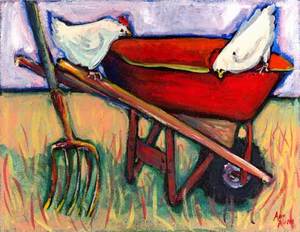I have decided to spotlight the poem “The Red Wheelbarrow “ by
William Carlos Williams. This poem is perhaps the most famous example of
imagist poetry. Imagist poetry is
centred on one exclusive image, an image so deeply focused that it becomes the
poem itself. Imagists insisted that a poem should get its power, not from the
poet’s clever style, not the symbolism of its content, but from the emotions
evoked by an image (An idea that can be traced back to the Japanese Haiku of
the 16th century). Williams
was an imagist whose aesthetic principles were largely focused on everyday life
and the common man. It was an aesthetic that went against the grain of the critically
acclaimed poets of the day such as the classicist, academic, and formal poetry
exemplified by the likes of T. S. Eliot.
“The Red Wheelbarrow” is a poem composed of a single sentence broken up at various intervals. The poem’s opening lines set the tone for the entire poem, and its form and meaning are united as one. It is a difficult concept to grasp, but it is not the lines on the page that is the poetry, but the image of the wheelbarrow itself. The opening lines play an integral part at centring the notion of the image as the poetry; “so much depends/ upon” the wheelbarrow. One of the things that strike me about the poem is how effective the poem is at breaking down the image. Notice how, in line 3, the monosyllabic words along with assonance, elongates the line and brings the reader’s attention to the unusual break between line 3 and 4. This effectively reduces the image to the sum of its parts the “wheel” and the “barrow”. We also receive a vivid injection of colour with “red”. This painterly language continues through lines 5 and 6, this time the adjective “glazed” is drawn to the reader’s attention, and transforms the image with the revelation of the rain. In the final lines we get the contrasting colour “white” of the chickens. Williams’ use of carefully selected diction, and unusual stanza breaks have effectively turned an ordinary sentence into a still life poem.
Williams has made the wheelbarrow the centre of the small
universe in which it exists. The other objects in the poem, water and chickens,
are defined by their relationship to the wheelbarrow. In line 3 he introduces us to the object by
referring to it as “a” wheelbarrow as if it is at that very moment that it is
being noticed. It is unfamiliar. When
“the” chickens are mentioned they already have a context and background they
are auxiliary objects, and minor details to the central image. This gravity
that the wheelbarrow has at the poems core reveals to the reader how
“everything depends upon” it.
The poem seeks to rethink some of the preconceptions of art
and experience. Where often poets will set out to be complex and ornate,
drawing attention to their language, Williams does the opposite keeping his
language very simple allowing the reader to capture the essence of the image
without imposing his thoughts. This feeds through into the poems structure;
Williams was reluctant to enslave his experience into a set poetic pattern thus
we get an inconsistent rhythm. What appears to be a poetic structure is not
imposed by the poet, but is decided by the experience.
The beauty of this poem is its ability to take a rather
everyday scene and turn it into an object of art with a space around it. It is
almost as if you can walk around the words and get to know the object for what
it is without the distraction of flowery poetics. As Jhan Hochman puts it, “The
Red Wheelbarrow is an anti-poem, or a poem attempting to be, not so much a
poem, but a hard object glazed with poetry.”



Comments
Post a Comment